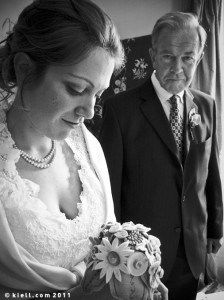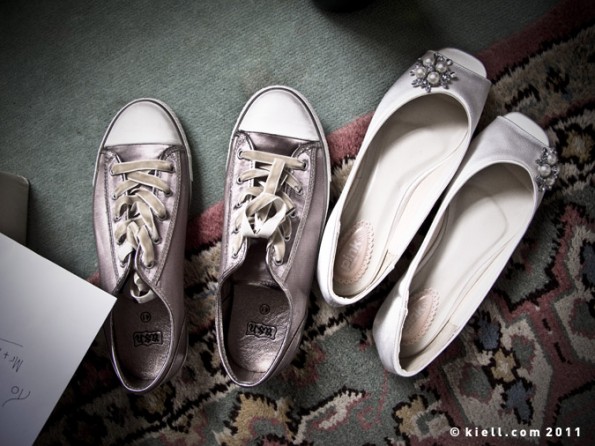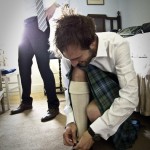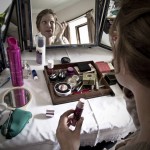Back in May I finally treated myself to a Canon G12, a piece of kit that I’ve wanted since it was released the previous year, and I set myself a challenge: use it to photograph a friend’s wedding.
My good friend Ruth was getting married not far from Aviemore in the Highlands of Scotland. Not having an official photographer she had asked all guests to take a load of snaps and share them afterwards. I was traveling up on the Caledonian Sleeper from London (highly recommended) and, given that my arrival was before 8am on the morning of the wedding, it made sense to head to the venue early, lend a hand with whatever needed doing and take lots of photographs of the preparations.
Normally, on the rare occasion that I photograph a wedding, I shoot with a Canon 5D, an EF 24-70mm, an EF 16-35mm, a Speedlight EX580 with extension cable, a pair of Pocket Wizards, a Vivitar 285 with light stand, and a reflector. Stripping this down to a compact camera was going to be interesting especially as I’d not used it before.

I read most of the manual on the way up on the train. Knowing how the autofocus and auto-exposure operates was crucial. I made sure that all face recognition was switched off and kept it simple. In the middle of the display is a box; point it at what you want to focus/expose on, half press, recompose, full press. 90% of the time, the thing you want in focus is the thing you want exposed correctly. In more tricky circumstances I knew that all of the G12’s controls would be right under my fingers, now even moreso with the appearance of the additional wheel next to the shutter release.
You have to work quickly at weddings and automatic settings on any camera are a godsend. This can of course present various issues, but if you know how and when they will arise, you can make sure you’re ready and react accordingly.


Next thing was to make sure the flash was off and didn’t mysteriously switch itself on. On-board flash is a truly horrible thing. I’d been tempted to take my Speedlight (compatible with the G12 hotshoe) and cable, but this was not in the spirit of the challenge and I have a habit of traveling light when possible. Typically at a wedding I shoot reportage parts of the day using available light but sooner or later the flash needs to go on. At this point you pray that the venue has white ceilings: point the Speedlight straight up and get a very flattering, diffused light. Compact cameras do not have a reputation for performing well in low light levels and with the G12 in hand, I was relying on recent technological progressions that have reduced grain at high ISO settings.
The G12 did an excellent job under the circumstances. On the odd occasion lack of light or a reflective surface would confuse the autofocus. If I did ignore its ability to focus, it still seemed to do a pretty good job. Its massive depth of field means that it’s tricky to mess it up completely.

This depth of field is also one of its disadvantages, however: it’s an inevitable aspect of any compact camera unless you’ve got a spare five grand lying down the back of the sofa and you buy yourself a Leica M9. The smaller sensors in compact cameras mean that you don’t get the gorgeous differential focus that you get with an SLR. This has its advantages (greater likelihood that your shots will be in focus) and disadvantages (can’t use out-of-focus regions for artistic emphasis).
Most wedding photographers will keep an eye out for any small details that make a wedding distinctive: flowers, table decorations, the bride’s corsage, the groomsmen’s button holes, etc. With an SLR, getting close and/or zooming in narrows the depth of field considerably which means that some regions will not be in focus. Sometimes this can be effective but often it means taking a number of versions to ensure that you can then pick the best one during post production. An option I will now consider is shooting any close-ups with the G12 as, yes, it will flatten the subject but it will mean that I can rule out differential focus when I don’t want it.

The G12 really impressed me when it came to shooting strongly back-lit subjects. Light creep was surprisingly controlled and even when I was careless with my initial ‘half-press’, it still made the right decision most of the time. Clever stuff.
Shooting at low light levels was impressive but I did run into a few problems that I hadn’t considered beforehand. Typically when shooting hand-held on a DSLR, your shutter speed can’t be allowed to drop below 1/60th of a second unless you’re in a situation where you can burn off a number of shots in the hope that you’ve held the camera steady enough in at least one photograph to be acceptable. Because of the physically smaller lens on the compact, slower shutter speeds are possible and I happily shot all the way down to 1/30th of a second without any camera shake blurring my shots. However, subjects’ movement became an issue and in my ‘keep everything auto’ approach, this was one occasion where I had to override, switching to AV mode to ensure a slightly quicker shutter speed.

The other massive difference is the lag on the shutter release. Weddings are about moments that convey emotion and not being able to rely on my own instinct was a frustration at times. The G12 comes with a ‘Quick Shot’ mode whereby the LCD is switched off and the lag between shutter release being pressed and the image being taken is dramatically reduced. This means relying on the viewfinder – not something I was prepared to do, especially wearing glasses. It also means that the autofocus and auto-exposure can’t be locked by half-pressing; instead, it readjusts constantly. I would have preferred some half-way house whereby I could focus and expose, trigger Quick Shot mode (ie, disabling the LCD) and shoot when the moment was right. All of that said, I was able to get used to the lag and get some half decent action shots.
Shooting the compact format of 4:3 as opposed to the SLR format of 3:2 was not a problem at the time but it’s something that frustrated me a little in post production as it just didn’t feel right. I massively prefer the 3:2 format but it seemed ridiculous not to use all of a compact camera’s sensor. Something I will get used to, no doubt.
The battery was superb. I took a spare but didn’t pack a charger and was a little apprehensive about my decision. As it turned out, I didn’t even dent the first battery despite shooting and reviewing over 400 shots.
Given its price you are likely to wonder whether it’s worth the investment; these days you can buy an incredible, entry-level DSLR for a very similar price. For me it is a great way to be able to chuck a camera in a bag full of other stuff, grab spontaneous, non-intrusive photos and still have a huge amount of control over what’s in my hands. I could easily have bought a smaller, less expensive compact but there’s something about the G12 that makes me feel more like a photographer.
So will I be shooting any future weddings with the G12? Probably not but it will certainly be in my bag.
This post is written by Andy Day. He is a professional photographer who primarily photographs the movement disciplines of Parkour and Buildering. He is well renowned for his skill and his photographs have appeared routinely in a number of magazines. Follow him on Twitter, Tumblr,



































i own this camera and it’s a fine camera on auto or P alone. very capable and great camera to use.
“Shooting the compact format of 4:3 as opposed to the SLR format of 3:2 was not a problem at the time but it’s something that frustrated me a little in post production as it just didn’t feel right. I massively prefer the 3:2 format but it seemed ridiculous not to use all of a compact camera’s sensor. Something I will get used to, no doubt.”
funny, i find 3:2 to be odd. sometimes i change the aspect ratio to 3:2 or 6 x 6, but love 4:3. you did a great job with the camera.
Thanks V. I guess it’s a matter of what you’re used to. I recently started playing with Instagram on the iPhone and thought that the square format would drive me insane. Turns out that I love it, so maybe I just need to shoot more on the G12. :)